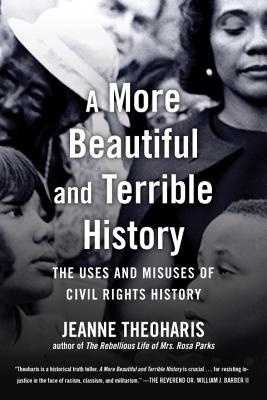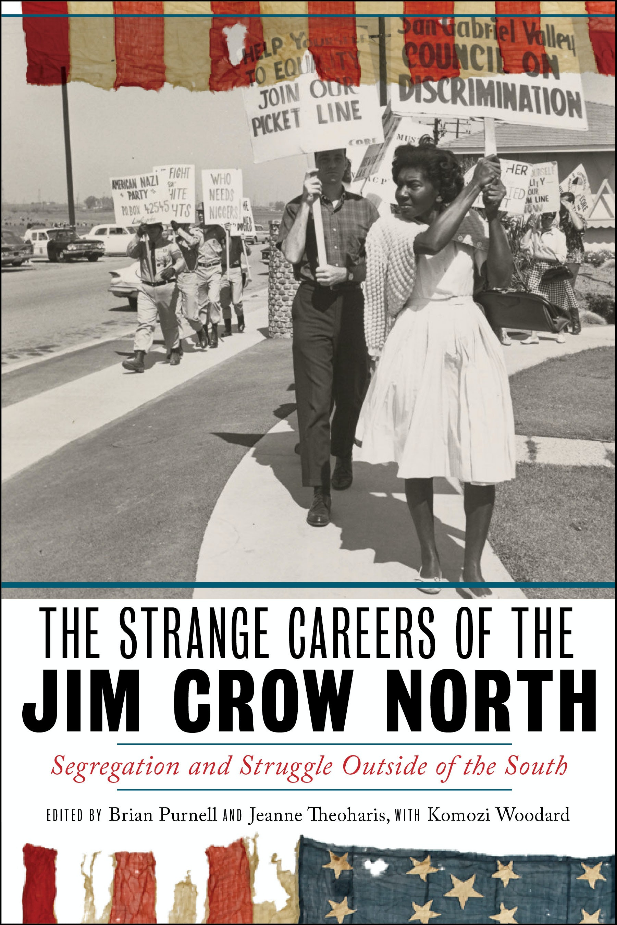By Jeanne Theoharis
Reprinted from The Emancipator
In marking the 40th anniversary of Boston’s court-ordered school desegregation in 2014, most articles and events revolved around the Boston busing “crisis” and not the Black struggle that compelled the city to face its own entrenched racial inequity.
As they had done 40 years earlier, many city officials, citizens and journalists ignored the three decades of Black organizing against segregation and educational inequality that led to Judge W. Arthur Garrity Jr.’s far-reaching ruling in Morgan v. Hennigan — issued on June 21, 1974 —to make it seem like an unfortunate “crisis” had befallen the city. Framing the issue around busing had long been a way to cover up pervasive, state-sponsored segregation in Boston and make it appear that the city struggled with a different problem than its counterparts in Little Rock, Arkansas, or Montgomery, Alabama. Now that we’re at the 50th anniversary, we need to do better.
A fuller history of Boston’s court-ordered desegregation began decades before Garrity’s decision. A mother of three named Ruth Baston called the NAACP in 1950, shortly after she learned that a White friend’s kids were being taught science in school, but her daughters weren’t. She also learned the NAACP didn’t have a subcommittee on education, so the organization asked her to chair one. Baston said yes, and her life “changed profoundly.” From its formation in 1950, the NAACP’s Boston public school subcommittee sought to demonstrate the segregated nature of the city’s schools.
Batson and her subcommittee faced deep opposition over whether segregation even existed in Boston’s public schools. “We were ‘raising a false issue,’” explained Batson in an interview. The NAACP subcommittee saw firsthand that keeping Black students in separate, overcrowded facilities was a way for the Boston School Committee to provide Black students with an inferior education. Four of the district’s 13 Black schools had been recommended for closure for health and safety reasons, while eight others needed repairs to meet city standards. Per-pupil spending averaged $340 for each White student, which was $100 more than for a Black student. The curriculum at many Black schools was outdated and racist. Rather than tracking Black students into college preparatory coursework, the school district instead primarily directed them into manual arts and trade classes.
“You could live on the same street and have a White neighbor, as I did,” parent-activist Ellen Jackson observed. “And you went to one junior high school and she went to another junior high school. … It was not de facto at all.” In addition to the racial gerrymandering of attendance zones, the School Committee reserved the overwhelming majority of jobs for White applicants through racially discriminatory hiring and promotion practices. Black people made up only half of 1% of the city’s teachers, and there were no Black principals in the system.
The NAACP took its argument to the School Committee in June 1963. Supporters packed the hearing, while more than 800 congregated outside the building singing freedom songs. Batson laid out the NAACP’s 14-point program, decrying the existence of “de facto segregation,” curriculum bias, and tracking and hiring discrimination in Boston Public Schools (BPS). In response, according to Batson, “we were insulted. We were told our kids were stupid and this was why they didn’t learn.” According to Batson, the subcommittee also found a “general consensus” among principals that Black students did not do as well as White students because “the parents did not seem to care.”
When William O’Connor became the new head of the Boston School Committee in 1964, he declared, “We have no inferior education in our schools. What we have been getting is an inferior type of student.” Fellow school committee member Joseph Lee concurred, saying, “The Negro can make their schools the best in the city if they attend schools more often, on time and apply themselves.” Such cultural arguments blamed Black students and their parents for educational inequities present in the city, providing a palatable way for Boston’s liberals to justify segregation in different terms from Southerners.

To continue the pressure on the Boston School Committee, Black community leaders organized a boycott. In February, nearly half of the city’s Black high school students stayed out of school, participating in Freedom Schools instead. The School Committee then agreed to a second hearing with the NAACP, but shut the meeting down when civil rights leaders used the phrase “de facto segregation.” Calling it “a horrible time to live in Boston,” Batson explained, “The press came out: NAACP is wrong, … We got very little public support and we got absolutely no political support. … All kinds of hate mail. … There were people who could not accept the fact that this horrible thing was happening in Boston.”
By the mid-1960s, the term “busing” had emerged as a useful political phrase and organizing tool for White Bostonians eager to oppose desegregation while still distinguishing themselves from their White Southern counterparts. School committee member Louise Day Hicks — who later won a city council seat and became the public leader of the anti-desegregation movement — played on fears of “forced busing” while claiming to be surprised at being called racist. Characterizing those pushing for desegregation as “outsiders,” she asserted “there has never been any discrimination in the city of Boston and those who say there is are doing a great disservice to this great city.”
In actuality, Boston children were already being bused without objection from White parents or politicians — often to maintain segregation. Refusing to rezone, and with Black schools desperately overcrowded, the school committee moved to institute double-session days in Black schools rather than bus Black children from overcrowded schools to White schools — even though White children were bused to other White schools to eliminate overcrowding. Cutting the school day in half, a double session meant one group of Black students would go to school in the morning for four hours and a second group would go to school in the afternoon. When Black parents protested this drastic shortening, the committee gave up the idea but did nothing to alleviate the overcrowding.
After two decades of meetings, rallies, student walkouts, parent organizing efforts, community initiatives and independent schools, there was still little change in BPS. And so Black parents with the NAACP decided in 1972 to file a federal suit against the school committee as a last resort, called Tallulah Morgan v. James W. Hennigan. At the time, 50 of the 201 schools in BPS taught a majority of the city’s Black students, and only 356 of 4,500 teachers were Black. By 1972, there were few neighborhood schools in Boston; 85% of high school students in Boston were already being bused, and thousands of White students not ensconced in all-White neighborhoods were bused past Black schools to White schools. In 1973, the School Committee willingly gave up $65 million in state and federal funds rather than desegregate schools.
In June 1974, Garrity found that the Boston School Committee had “knowingly carried out a systematic program of segregation affecting all of the city’s students, teachers and school facilities.” He explicitly eviscerated the city’s claim of “neighborhood schools,” and ordered comprehensive desegregation to begin in September. This included mandates for hiring more Black and Latinx teachers and the desegregation of 23 of the 65 racially imbalanced schools through school pairings and busing.
The start of the school year on Sept. 12, 1974, provoked some of the ugliest anti-desegregation demonstrations in the history of the civil rights movement. Crowds of Whites harassed Black students trying to desegregate White schools, and often their harassment turned violent. Thousands of White families kept their children home rather than sending them to a desegregated school. City council members and the police union proudly announced their opposition. Locals stoned buses carrying elementary school students. Nine Black children were injured and 18 buses were damaged. Black students desegregating South Boston High School were met by a mob of White people throwing rocks, bottles, eggs and rotten tomatoes, and yelling, “Niggers, go home!”
The situation grew worse over the weeks. Fights broke out in the schools, and White crowds continued their attacks on Black students and bystanders. Black students also bravely persevered. “If they run us out of that school, they can run us out of the city,” one Black student said in explaining her decision to keep attending school despite the violence. “It’s not the bus, it’s us,” Student Nonviolent Coordinating Committee co-founder Julian Bond observed at a rally.

Even White middle-class neighborhoods, known as the High Wards, experienced significant racial violence and White resistance. Working-class South Boston was pictured as the problem in much of the media, with racism rendered as a low-class problem in the city. Massive organizing and marches by Black residents in 1974 and 1975 also received much less attention from the press. Unlike news coverage of Southern struggles, which drew attention to the deep inequalities Black protests, most television and print coverage of these Northern struggles sympathized with White families and largely foregrounded their perspectives.
A month after the BPS school year began, then-President Gerald Ford joined in, pronouncing, “I respectfully disagree with the judge’s orders.” Quickly following suit, Boston Mayor Kevin White committed $200,000 of city funds to a fruitless appeal of Garrity’s order. Most of Boston’s City Council proudly stood with the White resistance. And a young senator from Delaware, Joe Biden, opposed busing, calling it “asinine.”
Following the media of the time, to this day many writers continue to frame White Northern opposition to segregation differently from Southerners. While “Southern segregationists” sought to prevent school desegregation, similar movements in Northern cities are often described as “White backlash” or “anti-busing movements,” and rarely termed segregationist.
Such framings reached their height in J. Anthony Lukas’s “Common Ground,” which won a Pulitzer Prize in 1986. The book traces the experiences of three Boston families between 1968 and 1978: the Black, working-class Twymons; the Irish working-class McGoffs; and the Yankee middle-class Divers. Still cited as an indispensable resource decades later, “Common Ground” discounted the role of Black leaders and parent activists as key players of the decade, and focused on a Black family that was not active in the community and whose children embodied a variety of social ills. By framing it as the busing crisis and not as massive White resistance that was supported on all levels of power — and resulted in school desegregation — Lukas’ book rendered understandable Northern White defense of “their neighborhood schools.” It also fit with contemporary political interests to treat Northern busing as hard on everyone. For Black Bostonians, “Common Ground” became the “Mississippi Burning” of Boston’s movement, and Batson would devote the last decades of her life trying to repudiate its claims.
Fifty years after this violent resistance, it is time to reject the framing of Boston’s busing crisis to honestly mark what happened. Black people engaged in decades of activism before and after the Brown v. Board of Education ruling to challenge Boston’s educational segregation, and faced massive White resistance and gaslighting. Finally, a federal judge ordered BPS to comprehensively desegregate.
Yet most White Bostonians across social classes, many in the national media and even the president found this to be a bridge too far. They didn’t see a problem, nor did they want to desegregate. However, they did want to continue to differentiate their resistance from Southern segregationists. Framing it as Boston’s busing crisis helps render Northern school desegregation — and Boston’s, in particular — as foolhardy, disruptive and, ultimately, unnecessary. Looking at the Cradle of Liberty with clearer eyes reveals how segregation was a constitutive part of the city, the lengths many people went to protect (and deny) it — and the change still needed today.
This article first appeared on The Emancipator and is republished here under a Creative Commons license.








Twitter
Google plus
LinkedIn